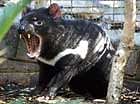

The furry black animals spread a fast-killing cancer when they bite each other’s faces. Since the disease’s discovery in 1996, their numbers have plummeted by 70 per cent. There’s no treatment, and little hope of finding one until scientists better understand what’s fuelling this bizarre “devil facial tumour disease”.
So an international research team picked apart the cancer’s genes, and discovered that it apparently first arose in cells that protect the animals’ nerves.
The surprise finding, reported in Friday’s edition of the journal Science, has led to development of a test to help diagnose this tumour. Next, scientists are hunting the mutations that turned these cells rogue, work they hope could one day lead to a vaccine to protect remaining Tasmanian devils.“The clock’s ticking,” said lead researcher Elizabeth Murchison of the Australian National University. The devils, known for powerful jaws, fierce screeches and voracious consumption of prey, are the world’s largest marsupial carnivores. So what triggered this cancer, which causes tumours that grow so large on the face and neck that the animals eventually can’t eat?
It didn’t jump from another species, said Murchison. Tasmanian devils are prone to various types of cancer. Those mutations went far beyond a typical cancer. When one sick animal bites another, it transplants living cancer cells that form a copy of the first animal’s tumour.
Deccan Herald is on WhatsApp Channels | Join now for Breaking News & Editor's Picks